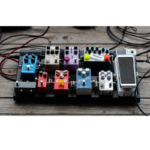The melodic minor scale is a unique and versatile tool for guitarists, blending both major and minor tonalities. Unlike the natural minor scale, the melodic minor provides a distinctive sound, making it a favorite in genres like jazz, classical, and even fusion. In this blog, we’ll break down how to use the melodic minor scale, how it applies to your guitar playing, and give examples of famous songs that utilize it.
What Is the Melodic Minor Scale?
The melodic minor scale differs from other minor scales in that it raises both the 6th and 7th degrees when ascending, and reverts to the natural minor scale when descending. This creates a more melodic and smoother sound in ascending lines while maintaining a minor, darker feel when descending.
For example, in C melodic minor:
- Ascending: C – D – Eb – F – G – A – B – C
- Descending: C – Bb – Ab – G – F – Eb – D – C (same as the natural minor).
Many modern musicians, especially in jazz, use the ascending version both ways to maintain consistency in improvisation.

Download the ebook “SoloCraft”!
SoloCraft is the ultimate guide to mastering guitar soloing, designed for players of all levels. Packed with step-by-step lessons, pro-level techniques, and real-world examples, SoloCraft teaches you how to navigate the fretboard, craft expressive solos, and unlock your full potential as a lead guitarist. Whether you’re improvising, building speed, or adding emotion to your playing, SoloCraft gives you the tools to solo like a pro.
Download Now
Using the Melodic Minor Scale for Guitar Solos
- Improvise Over Minor Chords: The melodic minor is perfect for minor or minor-major 7th chords. For instance, over a Cm(maj7), using the C melodic minor scale highlights the tension between the minor 3rd (Eb) and the major 7th (B), creating a sophisticated, jazzy sound.
- Play Over Altered Dominant Chords: The melodic minor’s altered scale (its 7th mode) works beautifully over dominant 7th chords with flat or sharp alterations (e.g., G7b9 or G7#5). Jazz guitarists love this tension to resolve back to the tonic.
- Lydian Dominant Sound: The 4th mode of the melodic minor, Lydian Dominant, is commonly used over dominant 7th chords, especially in fusion and jazz. For example, playing C Lydian Dominant over a C7 chord gives a sharp 4th, adding complexity.
5 Practice Tips for Mastering Melodic Minor Patterns
- Learn the Five Patterns: Like the major and pentatonic scales, the melodic minor scale has five key positions across the fretboard. Practice moving seamlessly between these positions to unlock the full fretboard for soloing.
- Use Arpeggios: Practice the arpeggios associated with the melodic minor scale, such as Cm(maj7), Ebmaj7(#5), and F7. This helps to outline the underlying chords while improvising.
- Link Chords and Scales: Understanding how chords are built from the melodic minor (e.g., CmMaj7, F7, G7) allows you to use the scale more effectively in your solos and chord progressions.
- Focus on Phrasing: Create phrases by targeting chord tones within the melodic minor scale. This helps make your solos sound more melodic and structured rather than just running through scale patterns.
- Apply to Modes: Experiment with the modes of the melodic minor (such as Dorian b2 or Mixolydian b6) to create exotic sounds in your playing.
Famous Songs That Use the Melodic Minor Scale
- “Yesterday” by The Beatles: One of the most iconic uses of the melodic minor is in Paul McCartney’s vocal melody in “Yesterday.” The emotional depth comes from the scale’s ascending melodic lines.
- Jazz Standards: Songs like “So What” by Miles Davis and “Giant Steps” by John Coltrane often feature the melodic minor in solos and chord substitutions. These jazz masters use the scale for its tension and release properties, particularly over minor-major 7 chords.
- Classical Compositions: Many classical pieces use the melodic minor scale, especially in works by Bach and Mozart, who favored the ascending minor for its singing quality.
Incorporating the Melodic Minor Scale into Your Playing
The melodic minor scale is ideal for players who want to explore new textures and moods in their playing. Whether you’re a jazz guitarist looking to add sophistication to your solos, or a rock guitarist experimenting with different sounds, the melodic minor offers endless creative possibilities.
Try incorporating the scale in your next jam or songwriting session. Start by playing over minor chords and then expand to dominant chords using the altered scale or Lydian Dominant mode.
Join the Conversation
Looking to dive deeper into the world of scales and soloing? Join our Guitar Freaks Hangout Discord where we discuss guitar techniques, scales, and help each other improve our playing. You’ll also find exclusive exercises from my ebook SoloCraft to help you master the melodic minor scale and beyond. Join today and start improving your guitar playing with a supportive community!
This guide should give you a solid foundation for understanding and applying the melodic minor scale on guitar. Whether you’re composing, improvising, or expanding your theoretical knowledge, the melodic minor scale is a powerful tool that opens up new musical possibilities.

Download the ebook “SoloCraft”!
SoloCraft is the ultimate guide to mastering guitar soloing, designed for players of all levels. Packed with step-by-step lessons, pro-level techniques, and real-world examples, SoloCraft teaches you how to navigate the fretboard, craft expressive solos, and unlock your full potential as a lead guitarist. Whether you’re improvising, building speed, or adding emotion to your playing, SoloCraft gives you the tools to solo like a pro.
Download Now










